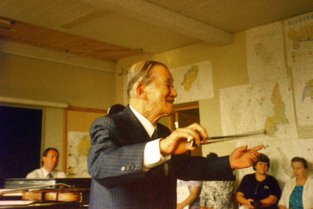
Dr. Shinichi Suzuki 1988 in Borlänge, Sweden
Schinichi Suzuki
In the 30s the Japanese violinist, Shinichi Suzuki was once asked, to teach a four year old boy to play the violin. For a while he asked himself how to do this. But one day it struck him that all children in the world learn to speak their native language by listening and imitating from an early age. He thought that this method must be the best way for learning. That was the start of the method, which he improved constantly during his whole life.
The development on the organ
The Suzuki Method™ for the organ was developed by the Swedish Suzuki pedagogue Gunilla Rönnberg and organist Lars Hagström.
In the documentary ”The Story of the Suzuki Organ Method” that was made 2019, you can see how it started and developed and was spread over the world during the years 1997 – 2020.
"The Story of the Suzuki Organ Method"
It began in 1998
In 1998 Gunilla Rönnberg contacted Dr. Haukur F. Hannesson, former Chairman of the European Suzuki Association (ESA) and Chair of the International Suzuki Association ISA, with a proposal to develop the Suzuki Method™ for organ. Gunilla’s background as a trained Suzuki piano teacher since 11 years and trained organist gave her a firm basis to take on this task.
The ISA and ESA gave Gunilla and Lars permission to run a test project for a year. In August 1998 Gunilla started 12 organ students. Six of them were former Suzuki piano students age 8-10, and six were beginners age 5-6. By choosing this division in age of the initial student group, Gunilla could test the proposed teaching material at different levels from the beginning.
Dr. Haukur F. Hannesson
In 1999, the organ becomes one of the instruments in the Suzuki method
In November 1998 the students had their first concert, and it was astonishing to see the 9 and 10 years old former Suzuki piano students, now playing the organ in a very skilful way. The concert in January 1999 was recorded and Haukur F. Hannesson presented the recording to the International Suzuki Association’s Board of Directors together with a proposal for printed music and a progression of pieces from Book One to advanced organ music. In March 1999, the International Suzuki Association officially made the organ a Suzuki Method™ instrument and granted permission to Gunilla Rönnberg and Lars Hagström to develop the method for the organ.
Development of organ technique for small children
One of the biggest challenges was to find a good way for developing the progression of organ technique, tonalization and relaxation for small children. The coordination between hands and feet was an easier task to solve, with pedal melodies to develop the pedal technique and chords base notes in the pedals in manual pieces, to develop coordination between hands and feet from the beginning.
Gunilla has through the years continuously started new beginners on the organ to continually refine the teaching of organ technique to achieve relaxation and good tonalization. Furthermore, she has explored and developed playing technique for higher levels of playing. One of her main emphasis is to make students play with a free and beautiful musical expression. Relaxed playing technique provides the prerequisites for this. Gunilla’s students have given a great number of concerts during the years. This has attracted attention and been much appreciated.
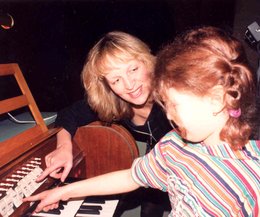
Gunilla and her daughter Madeleine 2000
Summar courses
In the summer of 1999, Gunilla Rönnberg and Lars Hagström organized the first summer course for organ students at the folk high school in Hjo. It was a great success. Six days of lessons in organ, choir, rhythm, theater, theory and piano accompaniment became like a mini organist education. The summer courses also included barbecues, swimming and excursions to castle ruins, etc. which was a great fun. As usual in the Suzuki context, the closing concert was very impressive. That summer course was then followed by another 3 summer courses in Hjo, until 2002.
Summer course in the folk high school
in Hjo, Sweden,1999
Publication of Suzuki organ books and recordings
All parts of the Suzuki Organ School, book 1 – 8, have been published by Alfred Publishing Co. Inc. in the United States. Alfred Publishing are the publishers of Suzuki Method™ core materials for all instruments
From the beginning, Gunilla was responsible for the material in the first books, since she had been teaching children by the Suzuki method for many years. Lars Hagström had long experience of teaching organists, so he picked out inspiering and developing literature for the higher music levels. He also recorded all music for book 1-5 and most of the pieces in book 6, where also Gunilla recorded 4 of them. He started to record music for book 7 and 8, but due to lack of time, Jeremy Chesman, organ professor at Missouri State University in the United States, took over and recorded most of those pieces.
All the work on the Suzuki literature has been financed by the Swedish Church.
Book 1 - 8 consists of the litterature for level 1 - 4 in the Suzuki organ method.
Level 5 consists of the mandatory piece Toccata, Adagio and Fugue in C Major by J.S. Bach, + an optional piece. (No book will be puslished for this)
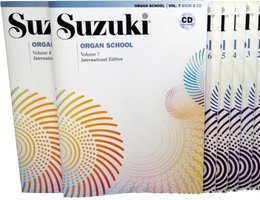
The Suzuki organ school, 8 volumes
Dr. Jeremy A. Chesman
The organ committee of the International Suzuki association
The members of the Suzuki Organ Committee were initially Gunilla Rönnberg - Chair, representing the European Suzuki Association (ESA), and Ernest Zenoniani, organist from the United States, representing the Suzuki Association of the Americas (SAA). In 2016, organist
David Clark from Australia became the representative of the Pan Pacific
Suzuki Association (PPSA), and since 2020, Jeremy Chessman represents SAA.
Gunilla Rönnberg and Dr. David Clark in Sidney 2012
Suzuki organ teacher training
Gunilla took all the 5 levels as piano Suzuki pedagoguge, and was appointed Suzuki Teacher Trainer on the organ by the European Suzuki Association in 2002. She has since then trained approximately 60 Suzuki organ teachers in Sweden, and has also given teacher training courses in the United States, in Chicago and Salt Lake City.
2001 – 02: Piteå musikhögskola
2002 – 03: The Royal accademy of music Stockholm
2003 – 04: The Royal accademy of music Stockholm + The university of music in Gothenburg
2004 – 05: The university of music in Örebro
2004 – 05: Chicago Suzuki Institute
2005 – 06: The university of music in Örebro
2006 – 07: Härnösand, level II, arranged by the Swedish church
2007 – 08: University of Salt Lake City
2009 – 09: The Royal accademy of music Stockholm
2010 – 11: The Royal accademy of music Stockholm
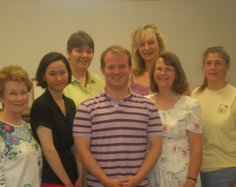
Teacher training course, Chicago 2005
As a result of Gunilla's Suzuki organ teacher training in Sweden, the organ has become a popular instrument for children to play. Professional organists have been encouraged by their churches to train to become Suzuki organ teachers. Many summer music courses for organ students have also been arranged in Sweden.
Because of requests from organists all over the world for an easily accessible teacher training education, Gunilla began to write on a web teacher education in 2012, and her husband, Kjell Hedenström, was filming.
In 2015 she published the web teacher training course, and since then she has also had follow-up courses at Lärkvallen's training center.
From the autumn 2020, she also began with interactive web teaching, both for children and youngsters, organists and pianists.
Marketing of the Suzuki Organ Method nationally and internationally
It has been a massive work to launch the organ as a suzuki instrument. Gunilla Rönnberg has targeted the media and church music organizations in Sweden and abroad to market the method.
The international interest has been substantional all the time, as the recruitment issue for organists is equally important in all countries of the world. Therefore, besides many lectures in Sweden, Gunilla has had many lectures abroad.
• Minneapolis, 2002 - 30th Anniversary Commemorative, American Suzuki Association
• Los Angeles, 2004 – American Guild of organists 47th National Convention
• London, 2004 – Suzuki Teachers Conference, lecheture
• Turin, 2006 – 14th Suzuki method World Convention, lecheture
• Köpenhamn, 2007 – Musikkonservatoriet, lecheture
• Esbjerg, 2007 – Musikkonservatoriet, lecheture
• Salt Lake City, 2007, Universityl of Salt Lake City, teacher training course
• Cambridge, 2010, European Suzuki Conference, lecheture
• Sidney, 2012, Australian Suzuki Association, teacher training and children course
• Strassbourg, 2014, lecheture
• Brussels, 2018, lecheture
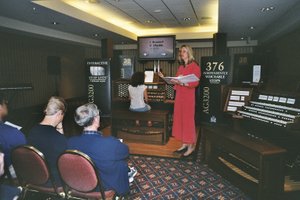
Lechture in Los Angeles 2004
The organ within the municipal music school
In 2007, Gunilla began working as director for a music school in Askersund, a small town in Sweden. With this she started organ teaching for the first time under the auspices of a municipal music school, in collaboration with the Swedish Church. The music school paid the salary for the teaching that took place in the church, which also bought pedal extensions. Gunilla also had 5 suzukior organ students in Örebro church communion until the fall of 2013 when she moved to Skåne in the south of Sweden. After 4 years in Skåne, Gunilla became director of a cultural school in Perstorp, where she also started Suzuki organ teaching, this time entirely under the auspices of the municipal cultural school. An organ placed in the school, and home practice organs for the students were purchased, all with adjustable benches and manuals.
New contexts for organ music and a new type of organists
The Suzuki organ studens have appeared in many contexts, even in quite unusual ways.
In Olaus Petri church in Örebro, an entire school was invited - 300 students, in the fall of 2005 to listen to their organ-playing friends' concert during school hours. The whole school, ie the audience, also got to sing a number of songs between the organ pieces. The organ pieces were everything from classical composers to music from Super Mario and The Final Count Down.
In 2008, 4 students between the ages of 5-15 had a lunch concert in the square in a small town called Kumla, during an organ festival. A 15-year-old student played among others, Toccata and Fuga in d minor by J-S.Bach.
As Gunilla's students grew older, several of them began to play other instruments as well. For example, they had rock groups, they sang jazz and danced street dance.
As both practitioners and listeners move across boundaries that no longer exist, a wide range of opportunities will open up in the future, where the organ will appear in many new contexts.
Gunilla teaching organ in the culture school 2020

Concert in Kumla square 2008
Gunilla Rönnberg © 2020 All rights reserved